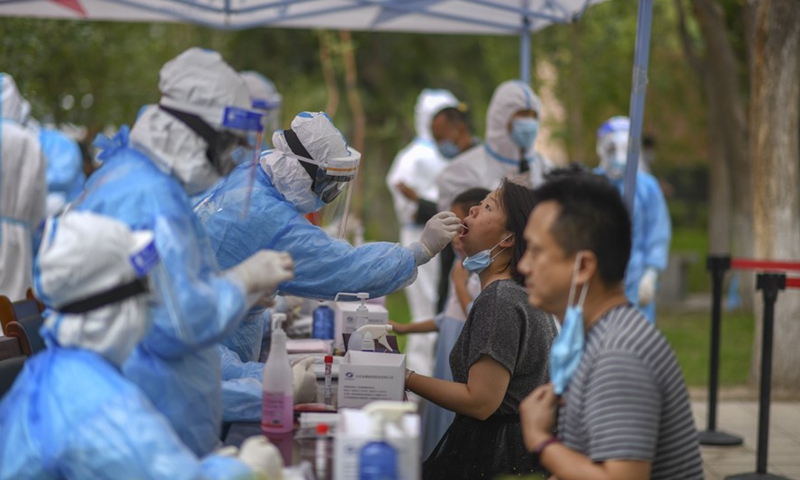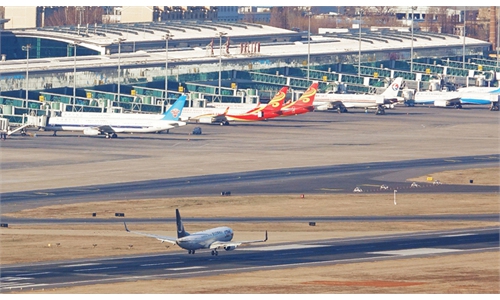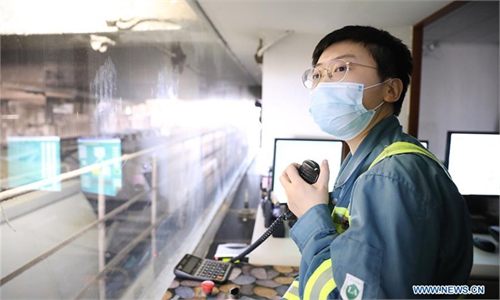
Medical workers collect swab samples for residents at Tianshan District in Urumqi, northwest China's Xinjiang Uygur Autonomous Region, July 20, 2020. Urumqi is carrying out free nucleic acid tests for all residents and people who are visiting the city, in a bid to screen for novel coronavirus infections and reduce the risk of the epidemic spread.Photo:Xinhua
The Chinese mainland recorded 68 new COVID-19 cases on Monday, marking the highest daily figure in three months, with numbers of infections in two virus clusters, Northeast China's Liaoning Province and Northwest China's Xinjiang Uygur Autonomous Region continuing to surge, propelling fears of a new wave of pandemic.
Although China still faces the threat of new outbreaks due to local community transmissions or from imported cases, the country's capability to contain the COVID-19 has been honed thanks to its experience in battling the virus for months, said Zeng Guang, chief epidemiologist for the Chinese Center for Disease Control and Prevention. He said that while more outbreaks are likely, they will not get out of control.
Fifty-seven of the 68 new cases were reported in Xinjiang, six in Liaoning and one in Beijing, the National Health Commission said on Tuesday.
Since the first new outbreak was reported in Xinjiang on July 16, the numbers of new daily infections have risen.
The sharp rise is expected as the outbreak was first detected in less than 14 days ago, which is one incubation period, Zhang Yuexin, a medical expert who is part of the Urumqi anti-epidemic group and director of the infectious disease department of the First Affiliated Hospital of Xinjiang Medical University, told the Global Times.
Next week is crucial for Xinjiang, because if the number of new cases continues to rise, then it means there are loopholes in the virus prevention measures, and the region needs to adjust its strategy, Zhang said.
The expert also attributed Xinjiang's high daily increase to the city's mass testing program. "The city's testing capacity ranges from 600,000 to 700,000 samples on daily basis. And there are enough hospital beds to cope with the current outbreak."
Six COVID-19 patients and asymptomatic carriers were discharged from hospital on Tuesday, the first batch of patients released from hospital in Xinjiang during this viral outbreak, said local officials.
After a COVID-19 cluster linked to a seafood processing company was found in Dalian, Northeast China's Liaoning Province last week, the city reported a total of 44 cases, and on Sunday, authorities announced that a citywide testing program would be rolled out.
As of Tuesday, positive cases linked to Dalian have spread to nine cities, including one in Beijing, which had announced the downgrading of its emergency response from Level II to Level III on July 20 after the Xinfadi outbreak was stanched in June.
The patient in Beijing had dined with friends from Dalian, who were later confirmed to be infected with the virus in Jinzhou, Liaoning Province. The woman then drove a private vehicle to Beijing on July 19. Tiantongyuan community, where the patient lives, was sealed off on Tuesday.
Fuzhou, the capital city of East China's Fujian Province, announced it was entering "wartime mode" after the discovery of an asymptomatic COVID-19 patient from Dalian.
"China has entered a 'new normal' virus prevention mode where we need to be cautious about the outbreak whilst trying to minimize the impact on people's normal work and lives," Zeng told the Global Times on Tuesday.
Zeng said that infection numbers in new virus clusters, such as Dalian and Urumqi, have been increasing quickly since July, and this curve echoes the trend in the world, where infections are also rising. This proves that outbreaks in other countries continue to affect China as it gradually opens the borders, he said.
"The size of China's outbreak is much smaller of course," said Zeng, who noted that the virus is sneakier than expected, and it will not stop or even recede in summer as many experts expected earlier.
Although China is facing a threat of sporadic local and imported infections, the country's management and virus-combating capability have been exercised during the constant battle against the virus. While the country's anti-virus measures become more precise and effective it is able to bring any outbreak, be it the current one, or any future emergences in the future, under control, said the epidemiologist.





